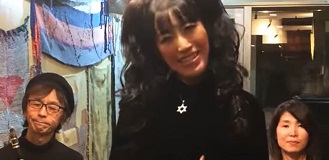NOTE: This is the first of several posts on Kwan Seum Bosal Chanting. Links to all the other posts are at the bottom of this post (in the section on “Sources and Resources”) Introduction Kwanseum Bosal Chanting is a practice that comes from the Korean Buddhist tradition. I don’t know of any closely similar practices […]
Category: chanting
The Heart Sutra Mantra
揭諦 揭諦 波羅 揭諦 波羅僧 揭諦 菩提 娑婆訶 a-je a-je ba-ra-a-je ba-ra-sung-a-je mo-ji […]
Mantra For Correcting Mistakes and Omissions (補闕真言)
There is a much shorter mantra in the Korean tradition with the same title. But this video is of a different, longer version used today in China. It is a really lovely video in which a mother is teaching the mantra to her daughter. 補闕真言 南無喝囉怛那,哆囉夜耶。 佉囉佉囉。俱住俱住。 摩囉摩囉。虎囉,吽。賀賀, 蘇怛拏,吽。潑抹拏,娑婆訶。 nā mó hē là dá nà […]
大悲咒 (Great Compassionate Mantra)
大悲咒 (Great Compassionate Mantra). This is one of the most popular mantras among present-day Buddhists. It is not to be confused with the longer mantra that is also often referred to as 大悲咒, and in English is often simply called “The Great Dharani”. That longer mantra is also known as “The Nilakantha Dharani”, but the […]
“Do not pass your days and nights in vain.”
In Chinese, the two character combination 光陰 (guāng-yīn) literally means “light-dark”. But the intended sense is like that in the English phrase “day in, day out”. Or even like that in the song “Sunrise, Sunset”. This phrase occurs in the ancient poem called “The Harmony of Difference and Sameness” (aka The Sandokai), in the line: […]
The Four Great Vows (四弘誓願)
The teachings are infinite; we vow to learn them all.
法門無量誓願學
法門 Pinyin: fǎ-mén. Meaning (literal): Dharma gate. Composition: 法 + 門 (“Dharma” + “gate”)
無量 Pinyin: wú-liàng. Meaning: immeasurable. Composition: 無量 (“no” + “measure”)
學 Pinyin: xué. Meaning: learn
五 蘊 皆 空 (five skandhas all empty)
In this post I’ll do the last four characters of the third line of the Heart Sutra. But perhaps before going any further I should point out that there is no standardization (at least none that I am aware of and/or comply with) for numbering the “lines” of the Heart Sutra. So these “lines” of […]
時 照 見 (from the third line of the Heart Sutra)
OK – now things get a little complicated. Here are the first three lines of the Heart Sutra, with some characters highlighted in two different colors. The color coding is explained below: 1—————————————————————————————– 摩 訶 般 若 波 羅 蜜 多 心 經 ma ha ban ya ba ra mil ta shim gyong great prajna […]
“… when practicing deeply …” 行深 in the second line of the Heart Sutra
觀 自 在 菩 薩 行 深 般 若 kwan ja jae bo sal haeng shim ban ya avalokiteshvavra bodhisattva practice […]
菩薩: Chinese for “Bodhisattva”
The Chinese name of Avalokiteshvara, as we saw in the previous post, is 觀自在. But the Chinese title of Avalokiteshvara is the next two words on the second line of the Heart Sutra: 菩薩. Here is the whole second line, with these two characters in red: 觀 自 在 菩 薩 行 深 般 若 […]





